WORM INFECTION AMONG SCHOOL CHILDREN OF UNIVERSITY OF PESHAWAR
Main Article Content
Abstract
Objective: To find out the pattern of worm infection among school children
of University of Peshawar.
Methodology: A total of 253 school children (male 137 and female 116) from
three different schools of University of Peshawar were randomly selected.
Worm infection of stool specimens from school children of University of Peshawar
were investigated through standard methods during September, 2013
to February, 2014. The data were analyzed with standard statistical procedures
using SPSS version 16, frequency and percentages were computed for
all variables. Results were presented in the form of tables.
Results: The overall infection rate was 23.7%, of which 10 % showed mixed infection.
Among positive cases Ascaris lumbricoides was the commonest (38.3
%), followed by Hymenolepis nana (15 %), Entamoeba coli (11. 7) %, Giardia
lamblia (10) % and Entamoeba histolytica in 5 % cases. The prevalence rate
for Taenia saginata and Enterobius vermicularis were 3.3 % and 1. 7 %, while
Trichurus trichiura and Ancylostoma duodenale were found in 1. 7 % and 3.3%
cases respectively.
Conclusion: Worm infection was found in a significant number of school
children of University of Peshawar. Ascaris lumbricoides was the commonest
worm infection.
of University of Peshawar.
Methodology: A total of 253 school children (male 137 and female 116) from
three different schools of University of Peshawar were randomly selected.
Worm infection of stool specimens from school children of University of Peshawar
were investigated through standard methods during September, 2013
to February, 2014. The data were analyzed with standard statistical procedures
using SPSS version 16, frequency and percentages were computed for
all variables. Results were presented in the form of tables.
Results: The overall infection rate was 23.7%, of which 10 % showed mixed infection.
Among positive cases Ascaris lumbricoides was the commonest (38.3
%), followed by Hymenolepis nana (15 %), Entamoeba coli (11. 7) %, Giardia
lamblia (10) % and Entamoeba histolytica in 5 % cases. The prevalence rate
for Taenia saginata and Enterobius vermicularis were 3.3 % and 1. 7 %, while
Trichurus trichiura and Ancylostoma duodenale were found in 1. 7 % and 3.3%
cases respectively.
Conclusion: Worm infection was found in a significant number of school
children of University of Peshawar. Ascaris lumbricoides was the commonest
worm infection.
Article Details
How to Cite
1.
Attaullah S, Khan BH. WORM INFECTION AMONG SCHOOL CHILDREN OF UNIVERSITY OF PESHAWAR. J Postgrad Med Inst [Internet]. 2016 Jul. 18 [cited 2025 Dec. 13];30(3). Available from: https://jpmi.org.pk/index.php/jpmi/article/view/1950
Issue
Section
Original Article
Work published in JPMI is licensed under a
Creative Commons Attribution-NonCommercial 2.0 Generic License.
Authors are permitted and encouraged to post their work online (e.g., in institutional repositories or on their website) prior to and during the submission process, as it can lead to productive exchanges, as well as earlier and greater citation of published work.


